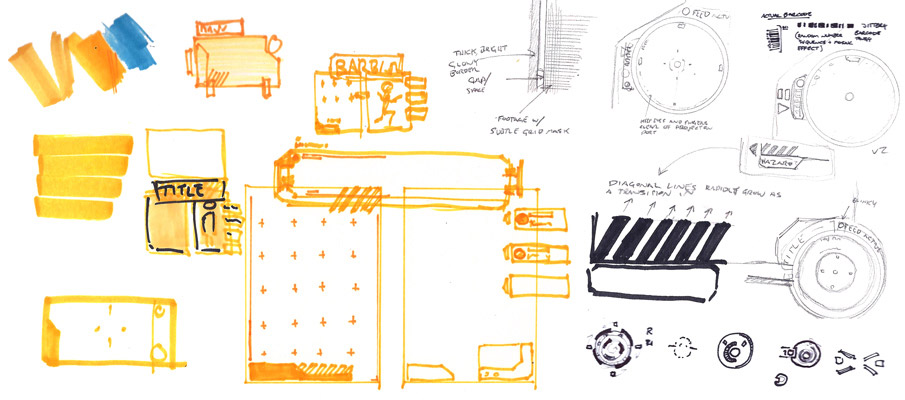
I'd be lying if I said my friends and I weren't big fans of older film. Each year, I co-host a 24-hour movie marathon dedicated entirely to a pre-selected genre. I decided that for this year's marathon, I should step up my efforts in creating the trailer. GALACTATHON was the chosen marathon theme- a full day of 70's and 80's classic sci-fi and their subsequent cheap knock offs.
Post-Apocalyptathon's trailer turned out great. But I wanted to do something with equal punch. With such a spacey subject matter, this opens the doors to go try some crazy new things.
After some concept sketches I decided to go with a sort of holographic-screens floating in space look. I did a series of tests of camera control and compositing techniques between After Effects and C4D, to make sure what I wanted to do was possible with the resources and time available.
Post-Apocalyptathon's trailer turned out great. But I wanted to do something with equal punch. With such a spacey subject matter, this opens the doors to go try some crazy new things.
After some concept sketches I decided to go with a sort of holographic-screens floating in space look. I did a series of tests of camera control and compositing techniques between After Effects and C4D, to make sure what I wanted to do was possible with the resources and time available.


The workflow was heavy— this was a fully independant project, so every step of the project had to be completed by me, regardless of how time consuming. I won't lie, this project took up a number of evenings and nights and weekends.
Each shot required 3+ plates composited on top of each other, a "starfield" plate (that matched and remained true to the camera's rotational motion. The "Action plate" with the holographic screens, film titles, and edited footage. And the holo-ship plate which rested on top/front of everything else.
General workflow was staggered, but after concepts and boards, I proceeded with editing down footage to use. This was a very edit-heavy project, and finding the right clips out of 12+ hours of footage to squeeze into 2 minutes is a sizable task. Further, I couldn’t just pick any clip. I needed to really enbody the feel of the marathon’s theme. The lofty, the weird, the dream, and the unsettling qualities of science fiction are things I love and eat up. You have 2 minutes to capture that, so each cut needs to count.
Most assets were created in illustrator. This was followed with rigging in AE, and making a rough edit cut in Final Cut Pro to getting everything matched to the audio track. Camera motion was exported to C4D, where starfield and holographic components were then animated and rendered out, then composited back into the AE file. Audio was manipulated and stylized in Soundbooth. Sections of alternating A/B camera shots were rendered out, and the final was edited in FCP.
This video is a quick breakdown of the compositing and effects process I had to go through for each shot— including alternating camera angles:
Each shot required 3+ plates composited on top of each other, a "starfield" plate (that matched and remained true to the camera's rotational motion. The "Action plate" with the holographic screens, film titles, and edited footage. And the holo-ship plate which rested on top/front of everything else.
General workflow was staggered, but after concepts and boards, I proceeded with editing down footage to use. This was a very edit-heavy project, and finding the right clips out of 12+ hours of footage to squeeze into 2 minutes is a sizable task. Further, I couldn’t just pick any clip. I needed to really enbody the feel of the marathon’s theme. The lofty, the weird, the dream, and the unsettling qualities of science fiction are things I love and eat up. You have 2 minutes to capture that, so each cut needs to count.
Most assets were created in illustrator. This was followed with rigging in AE, and making a rough edit cut in Final Cut Pro to getting everything matched to the audio track. Camera motion was exported to C4D, where starfield and holographic components were then animated and rendered out, then composited back into the AE file. Audio was manipulated and stylized in Soundbooth. Sections of alternating A/B camera shots were rendered out, and the final was edited in FCP.
This video is a quick breakdown of the compositing and effects process I had to go through for each shot— including alternating camera angles:
Programs used: 5
End result: Reception for the trailer was great! People were jazzed for the marathon, and attendance was up from the previous year's.
End result: Reception for the trailer was great! People were jazzed for the marathon, and attendance was up from the previous year's.

